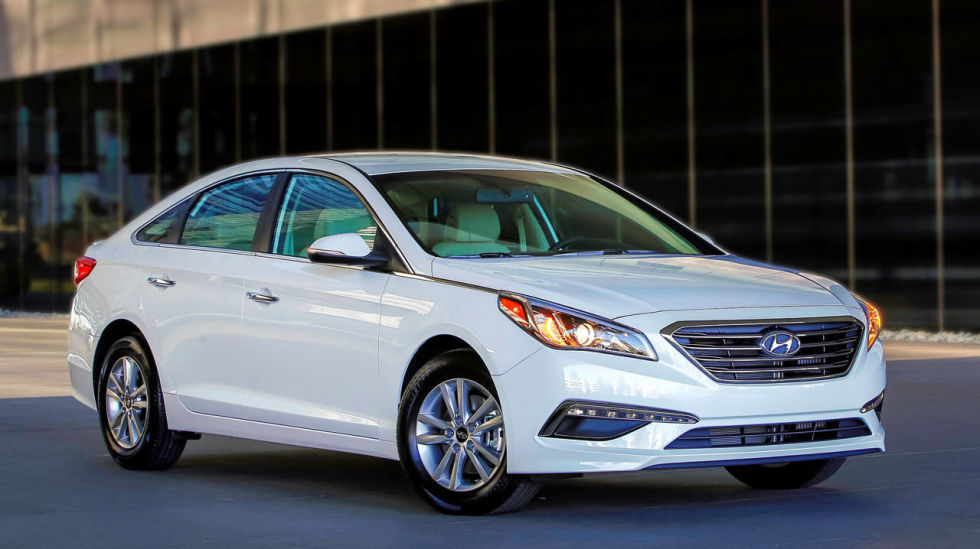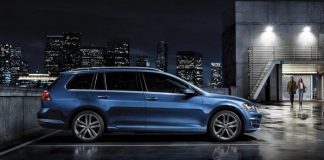It used to be pretty easy to pick a mid-sized family car.
The best – as defined by the general niceness of the thing as well as a reputation for value as impenetrable as the armor belt of a battleship – were basically two: The Toyota Camry and the Honda Accord.
Everything else was a second choice. The car you bought because you couldn’t afford a Camry or an Accord.
This included Hyundais.
They were not bad cars. Just not quite as good as the blue chips.
And, of course, they cost less.
They still do (well, mostly).
The difference now is they’re also solid alternatives to the blue chips. In some ways, they’re arguably preferable.
Their reputation rises accordingly.
The Sonata is Hyundai’s mid-sized family sedan, in the same general class as the Toyota Camry and Honda Accord. It’s available with your pick of three engines vs. the usual two – and can be had with more-than-the-typical for this this class amenities and features.
Base price is $21,750 for an SE with 2.4 liter engine and six-speed automatic transmission.
A top-of-the-line Limited with a turbocharged 2.0 liter engine stickers for $34,075
A Sport trim is available with the same turbo 2.0 engine as the Limited but gets a more aggressive 18-inch wheel-tire package, quad exhaust tips, a larger-diameter steering wheel and exterior/interior trim unique to this model.
Also available – and arguably the most interesting Sonata – is the Eco trim, which comes with a 1.6 liter turbocharged engine and a seven-speed automated manual transmission. This version of the Sonata can deliver almost 40 MPG on the highway, exceptional mileage for a non-hybrid (and gas-engined) mid-sized sedan. And it performs nearly as well as the 2.0 turbo engine.
Base price for this version of the Sonata is $23,275.
WHAT’S NEW
Base SE, Eco and Sport trims get an updated 7-inch LCD touchscreen with new apps, including Apple CarPlay and Android Auto.
Limited trims continue with the same-size (8-inch) touchscreen but also get the new apps, as well as an automated braking/collision avoidance system.
Lower price to start than the blue chips (SE Sonata lists for $1,320 less than base Camry LX).
Sonata Eco can deliver nearly 40 MPG on the highway – 5 MPG better than four-cylinder Camry – for about the same price as the Camry.
Nearly five inches more legroom up front than in Camry. Three inches more than Accord.
Available roster of high-end equipment includes: rear seat heaters, a cruise control system that can bring the car to a dead stop and get it going again without the driver touching the gas or the brake; a “smart” automatic trunk opener that pops open for you automatically just by standing behind it and “geo-fencing” (an electronic way to monitor teenage drivers).
Powertrain warranty lasts almost twice as long as the blue chips.
Get pricey as you move up the trims. A Sonata Limited stickers for $3,330 more than a comparably equipped V6 Accord EX; $2,750 more than a V6 Camry XLE.
Sport and Limited trims with 2.0 engine are under-engined (and under-performing) compared with V6 equipped versions of the Camry and Accord.
Backseat legroom is almost four inches less than in Camry; 2.9 inches less than in the Accord.
Long-haul reliability of turbo’d 1.6 (and 2.0) engines is still unknown. The not-turbo’d engines in Camry and Accord may prove to be the safer bets.
Ditto the technologically impressive – but very complex – automated manual transmission used in the Sonata Eco.
The base trim Sonata comes standard with a 185 hp 2.4 liter four – not turbocharged – paired with a conventional (hydraulic, with torque converter) six-speed automatic driving the front wheels.
This stacks up competitively with the base engines in the Camry (2.5 liters, 178 hp) and the Accord (2.4 liters, 185 hp).
Acceleration-wise, the Hyundai can get to 60 in about 8.2 seconds – not quite as quick as the four-cylinder Accord (7.8 seconds) but slightly quicker than the four-cylinder Camry (8.3 seconds).
Gas mileage-wise, it’s also a close race: 25 city/37 highway for the Hyundai vs. 25 city, 35 highway for the four-cylinder Camry and 27 city, 37 highway for the four-cylinder Accord. However, the Accord’s numbers are for a car equipped with the optional (read – you pay more) automatic transmission – which bumps the MSRP up to $23,005 ($1,255 more than the price of the SE Sonata, which comes standard with an automatic).
The manual transmission Accord’s mileage is lower: 23 city, 34 highway.
Optional with the Sport and Limited trims is a 2.0 liter four – this one turbocharged – and also paired with a six-speed automatic. It makes an advertised 240 hp – which is 28 hp less than the Camry’s optional V6 (3.5 liters, 268 hp) and 38 hp less than the Accord’s optional V6 (3.5 liters, 278 hp).
This is one of the few areas where the Sonata’s under-par vs. its rivals – and not just horsepower-wise. The performance of the 2.0 turbo-equipped Sonata is only slightly better than the performance of its four cylinder-engined rivals: Zero to 60 in the high sevens. This is way behind the pace of the V6 Camry – derided by the know-nothings as the Mrs. Doubtfire of family sedans – which can make the run in 6.2 seconds.
The V6 Accord is even speedier. It’s capable of getting to sixty in about six second flat.
This hurts the Hyundai – and not just because of the power/performance deficit. The V6-powered Accord and Camry also cost less than the 2.0 turbo-equipped Sonata, especially if we’re talking the top-of-the-line Limited trim – which costs literally thousands more than the V6-equipped/top-of-the-line Camry and Accord.
But, there’s a third option – and it’s where the Sonata earns back some points.
It’s the Eco Sonata – and its turbocharged 1.6 liter engine.
Although this engine is smaller – and on paper – much less powerful (170 hp) than the Sport and Limited’s available 2.0 liter engine, it is both an excellent performer and extremely economical: 28 city, 38 highway while also getting the Sonata to 60 in the high sevens.
This is quicker than the four-cylinder-powered Camry and nearly as fuel efficient as the Camry hybrid (39 MPG on the highway).
To be fair to Toyota, the hybrid Camry does rate 43 in city driving. However, it also has a base price of $26,790 – $3,515 higher than the Sonata Eco.
That could buy an ocean of gas at today’s roughly $1.60 per gallon.
Hyundai has fitted the Sonata with a comparatively large fuel tank: 18.5 gallons (the Camry’s is 17 gallons; the Honda Accord’s is 17.2). This plus the Eco’s near-40 MPG highway capability means you can trundle along for quite a while before pitting. Conceivably, up to about 700 miles – depending on how heavy your right foot gets. That’s diesel-esque highway legs, using a gas engine (which does not need to use diesel exhaust fluid – DEF – the stuff all new diesel-powered cars must be fed to keep their emissions within spec).
The 1.6 liter engine is paired with a seven-speed automated manual – a more technologically advanced box than the Camry and Accord’s conventional (hydraulic, with torque converter) and continuously variable (CVT) automatics. It has Sport Normal and Eco modes as well as a driver-selectable manual mode.
ON THE ROAD
The mid-sized “family car” segment doesn’t really exist anymore. It is in the process of changing into (cue Jennings/Dark Overlord from Howard the Duck)…. something else.
Even the Camry has gone sport sedany.
The Sonata, too.
It is sleeker-looking, firmer-riding, sharper-shifting and responding. 
Consider:
The Sonata’s optional turbo 2.0 engine – despite being a little gimpy vs. the Accord and Camry’s V6s – still makes more power than a Tuned Port Injection 5.7 liter V8 Corvette offered back in the ’80s.
We live in an era of orgiastic horsepower and performance … that we dare not use much.
Or at least not often.
For everyday A to B driving, the base 2.4 liter engine is plenty. It’s three seconds quicker to 60 than a Prius hybrid and strikes a good balance between cost to buy/performance you get and gas mileage delivered.
For more than plenty, go with the turbo engine.
But not the 2.0 turbo engine. I urge you to choose the 1.6 turbo. You’ll get similar acceleration potential when you need it and can use it…along with fantastic gas mileage.
Mid-sevens to 60 is nearly as quick as the Reagan-era Tuned Port Injection Corvette while using half the gas.
The performance (and economy) of the 1.6 engine is so good it makes the 2.0T’s look pretty bad.
The 2.0T Sonata Sport/Limited needs more power to make a case for itself – and not just vs. the V6 Accord and Camry but also (and especially) vs. the Sonata Eco.
The Sport trim is, as you’d expect, the firmest-riding of all the Sonatas – chiefly due to its short sidewall 18 inch tires (base trims come with 16s, the Limited gets 17s) but all Sonatas (and Camrys and Accords) ride firmly relative to what was once par for the course in the “family car” class.
Times change. When you corner, the hubcaps no longer get Frisbee’d into the woods.
Two other observations about the 1.6 liter Eco-engined Sonata. It is almost unreal how vibration-free this engine is. As dead-calm at idle as a hybrid when you’re stopped at a red light. Absolutely no indication through the steering wheel or shifter or anything else that the engine’s even running. I thought maybe my test car had auto stop-start and that the engine was off.
That’s how quiet/smooth it is.
Second, the Sonata can corner.
It doesn’t look it – and you might not think it – but this car puts out; it also has minimally invasive/pre-emptive traction control (the Camry’s is and – infamously – can’t even be turned off once the car’s moving) and won’t let you down if you decide to screw with that dude in the BMW 3.
Try it – see for yourself.
You can drift, throttle steer, make the tires squeal like the Toothless Man did to Ned Beatty. .
Hyuindai stylists seem to have been impressed by the Aston-Martin-ish themes of the Ford Fusion. Why not? Ford, after all, cribbed the Fusion’s look from Aston.
Remember what Bill Mitchell once said about robbing a bank rather than a liquor store.
It’s a good look – especially dramatic with the available smoked glass panorama roof.
The Sonata is bigger now, too.
Overall length now stands at 191.1 inches and the wheelbase has been extended slightly vs. the previous-generation Sonata to 110.4 inches. it is also 1.2 inches wider through the hips (73.4 inches vs. 72.2 for the old Sonata).
Inside, you will find Benz S-Class/BMW 7-esque front seat legroom: 45.5 inches. The Camry’s only got 41.6 inches up front; the Accord comes in second with 42.5. But the Toyota fires back with full-size-car backseat legroom – 38.9 inches vs. the Sonata’s kinda crampy 35.6 inches.
Still, a six-foot-three man (me) can sit in the Sonata’s back seats with several inches of air gap between his knees and the front seat. The Sonata’s meaningful deficit is backseat headroom – 38 inches – which will not leave much air gap between the top of your head and the car’s ceiling, if you’re a tall geek like me.
This is a common problem with all the cars in this segment – including the Camry, which has only marginally more headroom in the second row, 38.1 inches. The Accord’s got even less – just 37.5 inches. It’s all because of the design trend toward “sporty” appearance – which typically means steeper-sloped windshields and receding fastback rooflines.
It looks sexy – like high heels.
But high heels are not the ticket for long walks – and low rooflines suck for long trips in the back seats if you’re a tall geek like me. 
You can fit the Sonata out executive style, with rear seat heaters (standard equipment in the Limited trim) which is a very unusual feature in the class. Ditto the Adaptive cruise control, which can bring the car to a dead stop and then resumes the set speed without any input from the driver whatsoever.
Hyundai’s BlueLink system (standard in all but base SE trims) includes automatic crash response and teenager monitoring features such as curfew limits and geo-fencing. An interesting feature that Hyundai (and corporate cousin, Kia) offer is an Auto Hold system (press the button adjacent to the gear shifter) that keeps the car stationary without taking it out of Drive – or you having to keep your foot on the brakes. It’s handy for those long-red situations on your everyday commute.
The Sport trim gets a flat-bottomed/meatier-feeling steering wheel and quad exhaust tips, plus Xenon HID headlights. Limited trims get LED exterior lighting, upgraded leather trim and standard Blind Spot Warning and Rear Cross Traffic Alert. Major options include the full-length, panorama sunroof and manual side privacy screens, a larger 8-inch LCD touchscreen and a 10 speaker Infinity surround-sound system.
The GPS system’s map is upgradable via an easily accessible SD card slot just above the CD slot.
THE REST
The Safety Cult is a constant source of aggravation (and expense) to people who aren’t idiots and don’t need to be “proofed” against it. For instance, some of the Sonata’s in-car information cannot be accessed (or settings adjusted) unless the car is parked.
Not merely stopped.
This is done “for your safety” – on the assumption that most people are such marginal drivers they cannot be trusted to change settings while the car is moving.
This sort of thing is not peculiar to Hyundais, unfortunately. And Hyundai is far from the most preemptively nannyish.
All new cars are afflicted to varying degrees.
Stuff I really liked about this car: Large (but not senior-citizeny) buttons for most major secondary functions (audio, climate settings) on the center stack. Easy to see – and to use. I loved the handy secondary thumb switch on the steering wheel to increase or decrease the audio system’s volume. Also the well-designed cupholders (deep enough and wide enough to handle real-world-sized coffee cups) and the good-sized (and deep) center console storage area.
USB port and power points visible – and accessible.
The available “smart” trunk opener is neat, too.
It one-ups the foot-swipe systems you may have read about that some other cars offer. The Sonata can sense your presence – no foot swipe needed – and will pop the trunk for you automatically if you just stand behind it for 3 seconds or so with the transmitter fob in your pocket. 
Finally, there’s the warranty. The entire car is covered for five years or 60,000 miles. The powertrain (engine and transmission) for an incredible ten years or 100,000 miles. Toyota and Honda (and Ford) leave you on your own after just three years and 36,000 miles (whole car) and five years or 60,000 miles (powertrain).
THE BOTTOM LINE
Hyundai got where it is by offering slamming deals on cars that were credible alternatives to the blue chips. The latest Sonata (and other Hyundais, like the new Genesis sedan) take it up a notch. They’re still slamming deals.
But they’ve become more than just the value-priced alternative.
If you value independent media, please support independent media. We depend on you to keep the wheels turning!
Our donate button is here.
If you prefer to avoid PayPal, our mailing address is:
EPautos
721 Hummingbird Lane SE
Copper Hill, VA 24079
PS: EPautos stickers are free to those who sign up for a $5 or more monthly recurring donation to support EPautos, or for a one-time donation of $10 or more. (Please be sure to tell us you want a sticker – and also, provide an address, so we know where to mail the thing!)



















Oh, and I meant to also include this history timeline link: http://hyundaiamerica.us/an-american-success-story/u-s-history/ in my previous message. Had I added this fourth link though, Word Press would have probably flagged my entire post as Spam.
I am approaching old age I guess. There was no such thing as a Hyundai car in the US when I was growing up. I joined the military in 1982, and in 1988 I was stationed in South Korea, where Hyundai’s were manufactured. Most of the buildings and houses in that country were temporary structures back then. Many farmers drove around with walking tractors looking something like this: https://encrypted-tbn1.gstatic.com/images?q=tbn:ANd9GcQHL9DM-NfdGUb29vnqwDu9X_mQRMFarn9MQX-YP5gZlH4wkVCvQg or this: http://www.curbsideclassic.com/wp-content/uploads/2014/05/BCS-Utility_Dump_Cart.jpg pulling trailers piled high with crops. Their pick-up trucks looked nothing like ours: http://wardsauto.com/site-files/wardsauto.com/files/imagecache/large_img/uploads/2013/01/gm-korea-labo-pickup.jpg I very often saw vehicles on fire due to electrical or fuel issues in their country back then. For some strange reason they like to honk horns almost constantly at red lights. One Korean would probably honk the horn of his car in a days time more than an American would in his entire life. I am not kidding!
They have obviously made a lot of progress since then! I heartily congratulate them for that! I sure do wish that American automakers would start making genuine progress!
Hi Brian,
I was a kid when the Excel came out. Remember that one? It was a laughingstock on par with the Yugo. Thirty years later, look at them now!
“I am approaching old age I guess. There was no such thing as a Hyundai car in the US when I was growing up.”
I’m way past the “approaching” phase! When I was growing up, automotive diversity meant Studebaker, Hudson, Nash, and Kaiser rather than Toyota, Nissan, Hyundai, and Kia. The few foreign jobs around were mainly driven by sports-car enthusiasts or college professors. Then there was this little bug-shaped thing that sprang out of the ashes of Hitler’s Germany…
Jason, a friend in high school came up with a used Mini early sixties. That was The strangest car any of us had ever seen.
The Mini was never a big seller in the U.S., and was not sold here at all after 1967, so they were always pretty rare and it’s sideways engine with radiator by on the side and rubber suspension system probably would have seemed even stranger than a rear-engined VW Bug. (The latter became mainstream pretty quickly and were all over the place in the 1960s and 1970s. Nobody looked twice at them.)
The Mini’s bigger brother was sold here as the “Austin America” and that was a pretty common sight for a while, but they disappeared quickly due to terminal rust and mechanical failure. In particular they had a 4-speed fully automatic transmission which was unheard of at the time in a subcompact, but it sat in the engine sump and ran on shared engine oil which turned out to be a recipe for disaster.
“this little bug-shaped thing” – yes, I remember those. I also remember when my uncle was getting married in 1959 he was driving a Fiat of some sort. Eco-box, not sporty. When they tried to leave the reception his younger brother, who had stayed home on the farm rather than go to college, just grabbed the back bumper and lifted the drive wheels off the ground.
A buddy of mine had one of those little Fiats back in high school. It was not unusual for him to find it having been picked up by a few of the guys and put in strange locations and positions.
Great review! I remember when the gospel for family sedans was either getting a Toyota Camry or Honda Accord. They were always the reliable, bullet-proof cars that would last a very long time. Now it seams this segment has really matured, and you really can’t seem to go wrong with most of cars in this segment. It always seems to be the “safe” segment, in which you are generally going to get something reliable and hopefully not to convoluted compared to other vehicle classes. Can one even call these “family sedans” anymore, since they have so many features on them now that were once considered only in “luxury” cars?
I thought I might have to pass on this one but then I saw where it had a brake hold button, whoo, close one and geo-fencing plus curfew limits, dodged another bullet. The auto trunk feature is a great step up from having to push that button on the key fob just like similar cars that unlock the doors….so when you’re getting in another car beside it you can have a fight with the lock/unlock feature and a duel with two cars with the same systems.
Eric, do you think the “sporty” trend is a reaction by the automakers to show more “value” to buyers since this class of cars is no longer inexpensive?